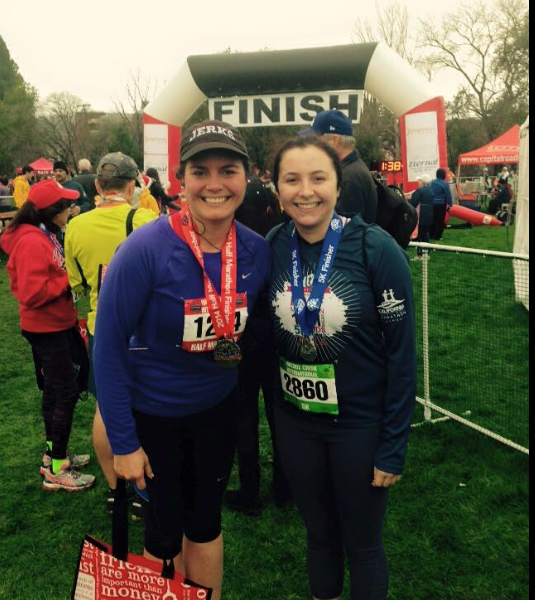Staff members participate in marathons: Science Teacher Maria Powell
Science teacher Maria Powell stood on tiptoes to reach for something between lab stations two and three in her biology classroom—crowded with freshmen doing the bacterial transformation lab—and felt the muscles of her right calf tear. “It felt like a zipper unzipping,” she said. She could not move, so science teacher Laura Pennington gave her a wheeled office chair. Powell spent the rest of the period moving on the chair to give instructions on the lab.
Powell had been training for nine months for a marathon without missing a day, and it was only three and a half weeks away. When she visited a doctor, blood was pooling around her ankles, and she could barely use her legs. “It was really upsetting because I hobbled in thinking it was all over,” she said. “I didn’t want to start over.” Fortunately, she recovered in time to attend the race. “It was surreal,” she said. “I couldn’t have imagined that, in that amount of time, I could have gone from [having a] non-functioning leg to running like that again,” she said. “That was kind of cool.”
That was her first marathon in 2012. Powell’s youngest child had just graduated from high school the year before, and she decided to train for the event with her free time. Ironically, she hated running when she was young, but she started training because her fellow science teacher Angela Merchant invited her to a half marathon event at San Miguel in 2008. Since then, she has run around ten half marathons, along with other shorter races.
Powell is attracted to running because of how peaceful she feels when she runs. “Nobody can bother me when I’m running,” she said. “I can’t really answer the phone or respond to texts. [When I started running], it was like the first time in my adult life that I had time just to myself.” One of her favorite races was the Wharf to Wharf Race, during which participants run for six miles from Santa Cruz to Capitola along the coastlines.
Her training depends on the races she is preparing for. She sets stricter time schedules if she is running a half marathon, but is more lax for 5K and 10K runs. Despite her experiences with racing, though, she prefers to run outside alone in her neighborhood. “When you’re on foot, you get to know every nook and cranny of your neighborhood, and you see things that you don’t see when you’re driving by,” she said. She is also very disciplined when it comes to her running schedule. “When I’m on a schedule, I just do it,” she said. “If I don’t get home until nine, then I run in the dark. The only thing that stopped me was injury.”
After she finishes her races, Powell checks her pacing and notices her immediate needs. “It’s not any kind of thoughts of being triumphant or anything, just taking stock,” she said. “You know, are all my parts still work- ing? Am I too cold? Am I too hot? What’s for lunch?”
Powell recommends running to anyone who wants to feel a sense of peace or well-being through running. “If you can run five miles and you think that that’s okay, then you could run six. If you can run six, then you can run seven, right? Maybe not tomorrow, but in a week or two,” she said.
Your donation will support the student journalists of Henry M. Gunn High School. Your contribution will allow us to purchase equipment and cover our annual website hosting costs.


